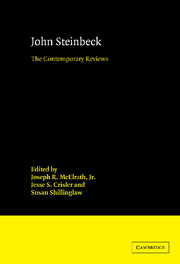Book contents
- Frontmatter
- Contents
- Series Editor's Preface
- Introduction
- 1 Cup of Gold (1929)
- 2 The Pastures of Heaven (1932)
- 3 To a God Unknown (1933)
- 4 Tortilla Flat (1935)
- 5 In Dubious Battle (1936)
- 6 Of Mice and Men (the novel, 1937)
- 7 The Red Pony (1937)
- 8 Of Mice and Men (the play, 1937)
- 9 The Long Valley (1938)
- 10 The Grapes of Wrath (1939)
- 11 The Forgotten Village (1941)
- 12 Sea of Cortez (1941)
- 13 The Moon Is Down (the novel, 1942)
- 14 The Moon Is Down (the play, 1942)
- 15 Bombs Away (1942)
- 16 Cannery Row (1945)
- 17 The Wayward Bus (1947)
- 18 The Pearl (1947)
- 19 A Russian Journal (1948)
- 20 Burning Bright (the novel, 1950)
- 21 Burning Bright (the play, 1950)
- 22 The Log from the Sea of Cortez (1951)
- 23 East of Eden (1952)
- 24 Sweet Thursday (1954)
- 25 The Short Reign of Pippin IV (1957)
- 26 Once There Was a War (1958)
- 27 The Winter of Our Discontent (1961)
- 28 Travels with Charley in Search of America (1962)
- 29 America and Americans (1966)
- 30 Journal of a Novel: The East of Eden Letters (1969)
- 31 The Acts of King Arthur and His Noble Knights (1976)
- 32 Working Days: The Journals of The Grapes of Wrath 1938–1941 (1989)
- Index
17 - The Wayward Bus (1947)
Published online by Cambridge University Press: 03 May 2010
- Frontmatter
- Contents
- Series Editor's Preface
- Introduction
- 1 Cup of Gold (1929)
- 2 The Pastures of Heaven (1932)
- 3 To a God Unknown (1933)
- 4 Tortilla Flat (1935)
- 5 In Dubious Battle (1936)
- 6 Of Mice and Men (the novel, 1937)
- 7 The Red Pony (1937)
- 8 Of Mice and Men (the play, 1937)
- 9 The Long Valley (1938)
- 10 The Grapes of Wrath (1939)
- 11 The Forgotten Village (1941)
- 12 Sea of Cortez (1941)
- 13 The Moon Is Down (the novel, 1942)
- 14 The Moon Is Down (the play, 1942)
- 15 Bombs Away (1942)
- 16 Cannery Row (1945)
- 17 The Wayward Bus (1947)
- 18 The Pearl (1947)
- 19 A Russian Journal (1948)
- 20 Burning Bright (the novel, 1950)
- 21 Burning Bright (the play, 1950)
- 22 The Log from the Sea of Cortez (1951)
- 23 East of Eden (1952)
- 24 Sweet Thursday (1954)
- 25 The Short Reign of Pippin IV (1957)
- 26 Once There Was a War (1958)
- 27 The Winter of Our Discontent (1961)
- 28 Travels with Charley in Search of America (1962)
- 29 America and Americans (1966)
- 30 Journal of a Novel: The East of Eden Letters (1969)
- 31 The Acts of King Arthur and His Noble Knights (1976)
- 32 Working Days: The Journals of The Grapes of Wrath 1938–1941 (1989)
- Index
Summary
Harrison Smith.
“John Steinbeck Does It Again.”
Saturday Review, 30
(15 February 1947), 14–15.
In the new novel we have all been waiting for John Steinbeck has abandoned the familiar, odorous waterfront of Monterey with its cannery row. Gone are the doctor and the docks, the warm-hearted girls who were all whores, and the drunks and the bums who were all more delightfully human than any man could possibly be who has money in his pockets and a balance in the bank.
The setting for The Wayward Bus is a neat and shining little lunch room, garage, and gas station set down under a clump of lofty trees forty-two miles below San Ysidro, where the highway meets a lesser road that rambles for forty-nine miles across the farms or mountainous landscape to meet the great coastal thoroughfare. From the beginning Steinbeck creates the illusion of complete reality. The little establishment of Juan Chicoy and his wife stands four-square and solid, the battered old bus he shuttles from one highway to the other is real, the landscape is the good earth itself, the drenching rain is wet. Mr. Steinbeck had expected to have the book ready for publication many months ago, for the scene and the nine characters who play their parts have lived in his mind for several years, and have, according to Lewis Gannett, excited and stirred him as they developed.
What he has attempted and has accomplished is to present the natural man, homo simplicimus, and to a lesser extent the natural woman, in glaring contrast to the artificial and glazed products of middle-class civilization.
- Type
- Chapter
- Information
- John SteinbeckThe Contemporary Reviews, pp. 291 - 312Publisher: Cambridge University PressPrint publication year: 1996



